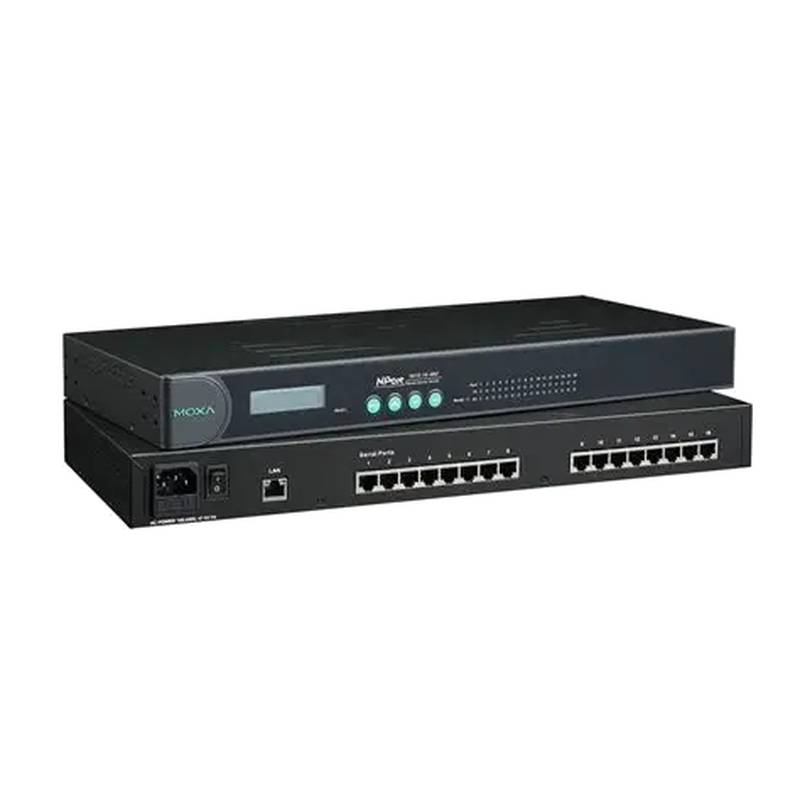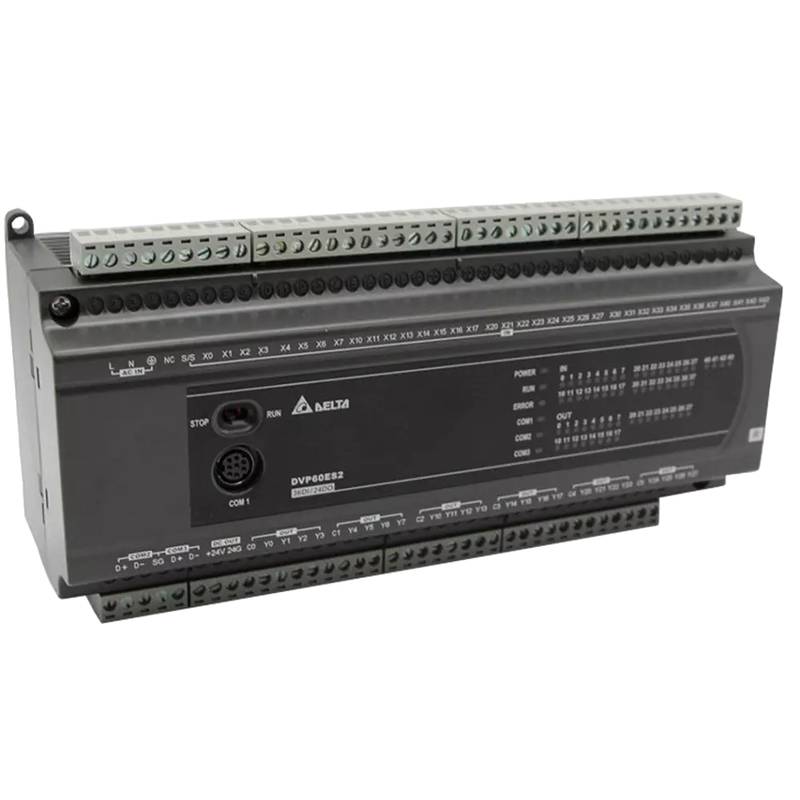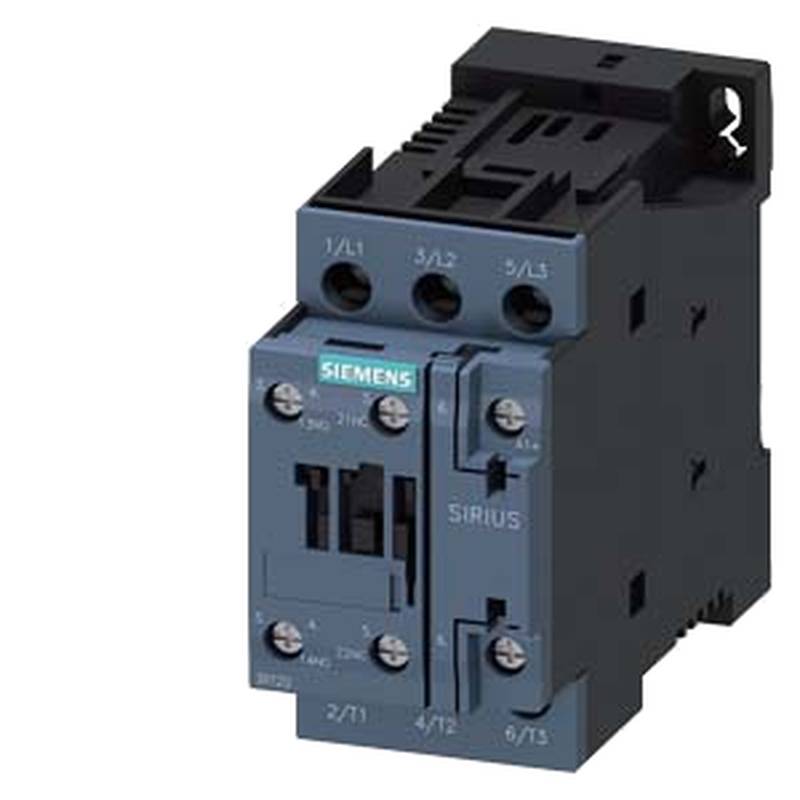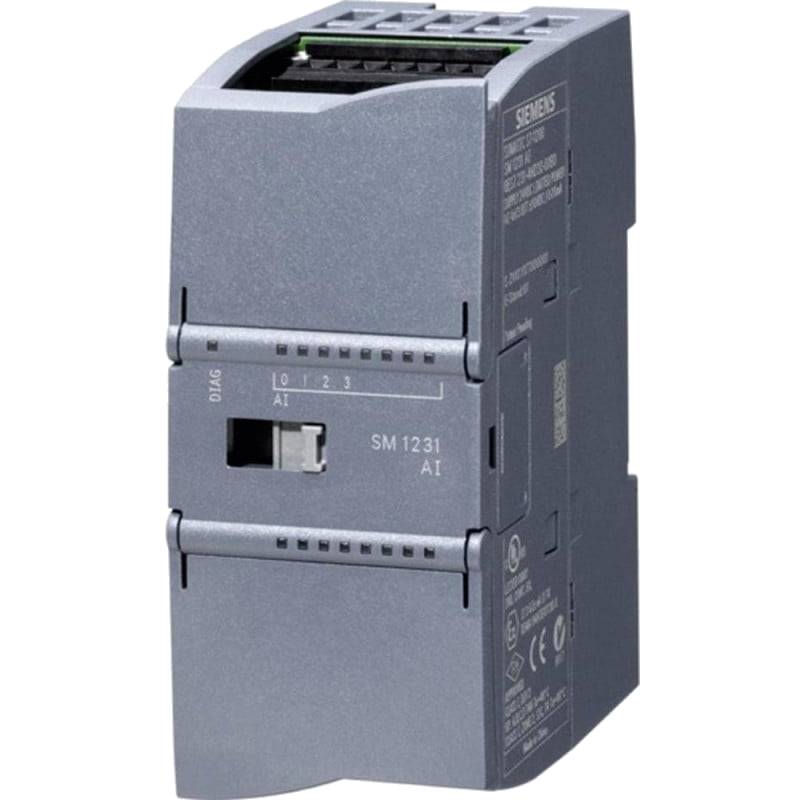
The Moxa NPort 5630-8 stands as a robust 8-port multi-interface serial server, engineered to bridge the gap between legacy serial devices and modern Ethernet networks. This device offers unparalleled flexibility with its mixed serial port configuration, supporting RS-232, RS-422, and RS-485 interfaces, a critical advantage for industries integrating diverse automation equipment. Its industrial-grade design ensures reliable operation in demanding environments, featuring a 10/100 Mbps Ethernet port, 15 kV ESD protection for serial ports, and a wide operating temperature range of 0 to 55°C. The NPort 5630-8 facilitates seamless data transmission, enabling remote monitoring and control of serial devices over TCP/IP networks, thereby enhancing operational efficiency and reducing downtime.
| Feature | Specification |
| :--------------------- | :----------------------------------------------- |
| Serial Ports | 8 (Mixed: RS-232, RS-422, RS-485) |
| Ethernet Port | 1 x 10/100 Mbps (RJ45) |
| Serial Interface Speed | Up to 921.6 kbps |
| ESD Protection | 15 kV on all serial signals |
| Operating Temperature | 0 to 55°C (32 to 131°F) |
| Power Input | 12-48 VDC |
| Mounting | DIN-rail, Wall-mount |
| Protocols Supported | TCP Server/Client, UDP Server/Client, Pair Mode |
| Management | Web Console, Telnet Console, Serial Console, Moxa Mgmt Suite |
Core Features & Market Positioning
The Moxa NPort 5630-8 distinguishes itself in the industrial automation market through its inherent flexibility and robust design. Its capability to host a mix of RS-232, RS-422, and RS-485 interfaces on a single unit significantly simplifies the integration of heterogeneous serial devices, a common challenge in legacy industrial systems. This mixed-interface capability reduces the need for multiple specialized converters, offering a cost-effective and space-saving solution. Furthermore, the integrated 15 kV ESD protection on all serial ports provides a vital layer of defense against electrical surges, ensuring device longevity and operational stability in environments prone to electrical noise or interference. This focus on reliability and adaptability positions the NPort 5630-8 as a preferred choice for critical infrastructure and manufacturing environments seeking dependable serial-to-Ethernet conversion.
Key Application Scenarios
The versatility of the Moxa NPort 5630-8 makes it indispensable across various industrial sectors. In manufacturing, it enables the collection of real-time data from PLCs, sensors, and machine tools equipped with serial ports, feeding this information into SCADA systems or MES for enhanced process control and predictive maintenance. For building automation, it facilitates the integration of HVAC systems, access control panels, and lighting controllers into a unified network, allowing for centralized management and energy optimization. In the energy sector, the NPort 5630-8 is deployed to remotely monitor and control substations, power meters, and environmental sensors, ensuring operational continuity and rapid response to anomalies. Its ability to connect serial barcode scanners, printers, and weigh scales also proves invaluable in logistics and warehousing for inventory management and tracking.
Practical System Integration Guidance
Integrating the Moxa NPort 5630-8 into an existing industrial network is streamlined by its user-friendly configuration options. Initial setup can be accomplished via a web browser, Telnet, or the serial console port, allowing engineers to assign IP addresses, configure network settings, and select operating modes (TCP Server, TCP Client, UDP, or Pair Mode) according to application requirements. For instance, setting up the device as a TCP Server allows multiple clients to connect to the serial devices simultaneously, ideal for centralized monitoring. Conversely, configuring it as a TCP Client enables the NPort to initiate connections to a specific server, suitable for distributed data acquisition. Wiring connections are straightforward, utilizing standard DB9 or terminal block connectors for serial interfaces and an RJ45 connector for the Ethernet link, with LED indicators providing immediate feedback on link status and data activity.
Operation and Risk Mitigation
Operating the Moxa NPort 5630-8 requires adherence to standard industrial networking practices to ensure optimal performance and safety. The device’s built-in firewall capabilities and secure management protocols (e.g., SSH, SSL) should be leveraged to protect against unauthorized access, particularly when deployed in sensitive networks. Regular firmware updates from Moxa are recommended to address potential vulnerabilities and incorporate new features, maintaining a robust security posture. Common operational issues, such as connectivity loss, can often be mitigated by verifying IP addressing, network cable integrity, and the correct configuration of serial port parameters (baud rate, data bits, parity, stop bits) to match the connected peripheral. The 15 kV ESD protection significantly reduces the risk of hardware damage from transient overvoltages, but grounding procedures should still be followed during installation to further safeguard equipment.
Scalability & Long-Term Value
The Moxa NPort 5630-8 offers considerable scalability, allowing organizations to expand their serial device connectivity as operational needs grow. Its ability to manage up to eight serial ports on a single unit reduces the physical footprint and complexity compared to deploying multiple single-port converters. The device is designed to integrate seamlessly with Moxa's broader portfolio of industrial connectivity solutions and management software, such as the Moxa Industrial Internet of Things (IIoT) platform, facilitating a unified approach to device management and data analytics. Compatibility with various industrial protocols and its support for standard networking technologies ensure that the NPort 5630-8 remains a valuable component within evolving industrial control systems and future IIoT initiatives, providing a long-term return on investment through its enduring relevance and expandability.
Frequently Asked Questions (FAQs)
Q1: What serial interfaces does the Moxa NPort 5630-8 support?
The Moxa NPort 5630-8 is designed for maximum flexibility, featuring a mixed array of serial interfaces. It supports RS-232 for straightforward, point-to-point communication, ideal for devices like terminals and printers. It also includes RS-422, which enables multi-drop communication over longer distances with higher signal integrity compared to RS-232.
Furthermore, the unit provides RS-485 support, a robust two-wire or four-wire serial interface well-suited for harsh industrial environments and network architectures requiring multiple devices on a single bus. This combination allows seamless integration of diverse legacy serial equipment into a single Ethernet network.
The specific configuration of mixed ports can vary, but the core offering is the ability to handle these distinct serial standards within one device, greatly simplifying system design and hardware consolidation.
Q2: How do I configure the IP address for the Moxa NPort 5630-8?
Configuring the IP address for the Moxa NPort 5630-8 can be accomplished through several user-friendly methods. The most common approach is using Moxa's powerful Windows-based utility, Moxa PComm Plus, which can discover NPort devices on the local network and allow for IP address assignment and parameter configuration.
Alternatively, users can access the NPort 5630-8 via its default IP address (often 192.168.127.254) using a web browser, or connect via a serial console cable to Telnet into the device and set the IP address and subnet mask through command-line interface commands.
For automated deployments, the NPort supports DHCP, allowing it to automatically obtain an IP address from a DHCP server on the network. This is particularly useful for large-scale installations where manual configuration of each device would be time-consuming.
Q3: What are the primary advantages of using a serial server like the NPort 5630-8?
The primary advantage of employing a serial server such as the Moxa NPort 5630-8 is the ability to seamlessly connect and manage legacy serial devices over modern Ethernet networks. This dramatically extends the lifespan of existing automation equipment, preventing costly replacements and enabling integration into digital infrastructures.
It provides centralized control and monitoring of distributed serial devices, allowing data to be accessed and managed from anywhere on the network, or even remotely over the internet. This enhanced accessibility improves operational efficiency, reduces the need for on-site personnel, and facilitates quicker troubleshooting.
Furthermore, serial servers like the NPort 5630-8 offer robust data transmission capabilities, often with features like TCP/IP encapsulation and redundant connection options, ensuring reliable communication even in challenging industrial environments.
Q4: Can the Moxa NPort 5630-8 be mounted on a DIN rail?
Yes, the Moxa NPort 5630-8 is designed with industrial mounting flexibility in mind. It natively supports DIN rail mounting, which is a standard in industrial control cabinets and enclosures. This allows for quick and secure installation alongside other industrial components.
The device typically comes with the necessary hardware or adapters to attach it securely to a 35mm or 32mm DIN rail. This ensures it remains stable and accessible within the control panel environment.
In addition to DIN rail mounting, the NPort 5630-8 often includes provisions for wall-mount installations, offering versatile options to suit different cabinet designs and space constraints.
Q5: What is the maximum serial data rate supported by the NPort 5630-8?
The Moxa NPort 5630-8 supports high serial data rates to accommodate demanding industrial applications. It is capable of achieving communication speeds of up to 921.6 kbps across all its serial interfaces (RS-232, RS-422, and RS-485).
This high baud rate ensures that even devices requiring rapid data exchange, such as high-speed sensors or advanced controllers, can be integrated without becoming a bottleneck in the network. This is crucial for real-time process control and data acquisition systems.
The actual achievable data rate will depend on factors like cable length, signal quality, and the specific serial communication protocol being used by the connected device, but the NPort 5630-8 provides the capability for high-speed operation.
Q6: Does the NPort 5630-8 offer any built-in security features?
The Moxa NPort 5630-8 incorporates several security features to protect sensitive industrial data and control systems. It supports secure management protocols such as HTTPS for web access and SSH for console access, encrypting communication between the administrator and the device.
The device may also include firewall capabilities, allowing administrators to define access control lists (ACLs) to restrict network access to specific IP addresses or ports, thereby preventing unauthorized connections. This helps to create a more secure network perimeter.
While not a full-fledged industrial firewall, these integrated security measures are critical for hardening the NPort device and the network segments it connects to, mitigating common cyber threats in industrial environments.
Q7: What power input requirements does the Moxa NPort 5630-8 have?
The Moxa NPort 5630-8 is designed for industrial power environments and typically operates with a wide DC input voltage range. This allows for flexibility in power sourcing, as it can connect to various DC power supplies commonly found in industrial settings.
The standard input voltage range is generally between 12 and 48 VDC, which accommodates a broad spectrum of power systems. This wide range also provides robustness against voltage fluctuations, ensuring stable operation.
It's important to use a reliable and properly regulated DC power supply that meets or exceeds the device's power consumption requirements to ensure optimal performance and longevity.
Q8: How does the NPort 5630-8 handle serial port errors or faults?
The Moxa NPort 5630-8 is equipped with diagnostic capabilities to help manage serial port operations and identify potential issues. It provides LED indicators on the front panel that offer real-time status of Ethernet link, data transmit/receive activity, and power status.
In case of communication problems, users can leverage the NPort's management interface (web, Telnet, or console) to check port status, review logs, and configure retry mechanisms or fail-over options. This aids in quick identification and resolution of connectivity issues.
The device's robust design, including 15 kV ESD protection on serial ports, inherently mitigates common hardware faults caused by electrical surges. However, for critical applications, implementing watchdog timers and redundant network paths can further enhance fault tolerance.
Q9: What is "Pair Mode" in the context of the NPort 5630-8?
"Pair Mode" (also known as patented Real COM Mode or Serial Tunnel) on the Moxa NPort 5630-8 allows two NPort devices to establish a transparent serial connection over an IP network. This effectively creates a virtual serial cable between two locations.
In this mode, serial data sent to a COM port on one NPort is automatically forwarded through the Ethernet network to the other NPort, and then delivered out of its serial port as if they were directly connected. This is ideal for extending serial communication over long distances.
This mode simplifies the integration of applications that expect a direct serial connection, as they do not need to be modified to understand TCP/IP networking. It's a straightforward way to create point-to-point serial links across different facilities.
Q10: How can the NPort 5630-8 integrate with Industrial Internet of Things (IIoT) platforms?
The Moxa NPort 5630-8 can serve as a crucial gateway for integrating legacy serial devices into IIoT ecosystems. By converting serial data to an Ethernet-based protocol, it allows these devices to communicate using standard IP networks, making them accessible to IIoT platforms.
Many IIoT platforms support common industrial protocols like Modbus TCP, which the NPort can often handle or convert to. Additionally, Moxa provides management software and APIs that can facilitate data extraction and integration with cloud-based IIoT solutions.
For more advanced IIoT integration, the NPort can be paired with edge computing devices or gateways that perform data pre-processing, filtering, and aggregation before sending relevant information to the IIoT platform, optimizing bandwidth and enabling smarter analytics.

























